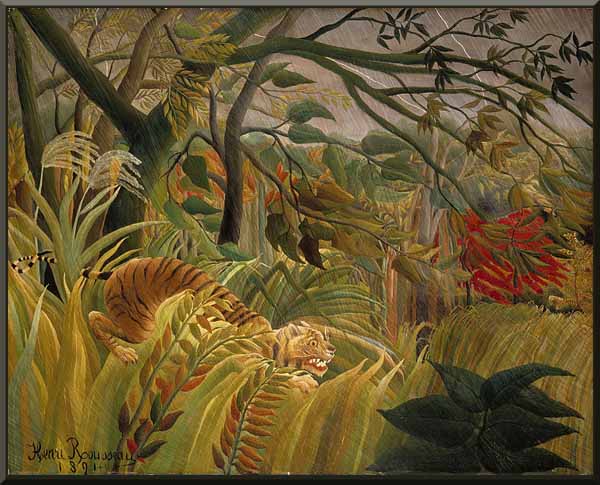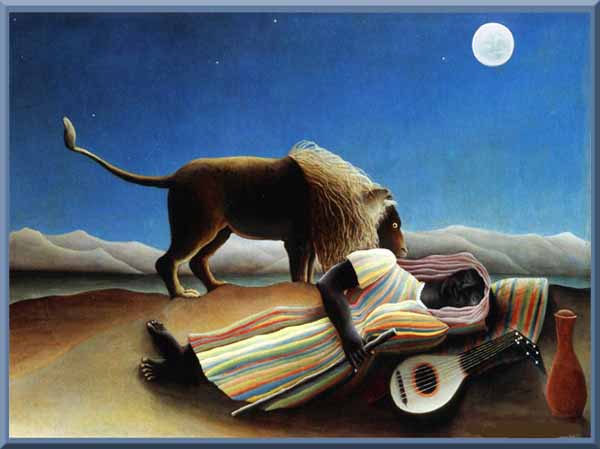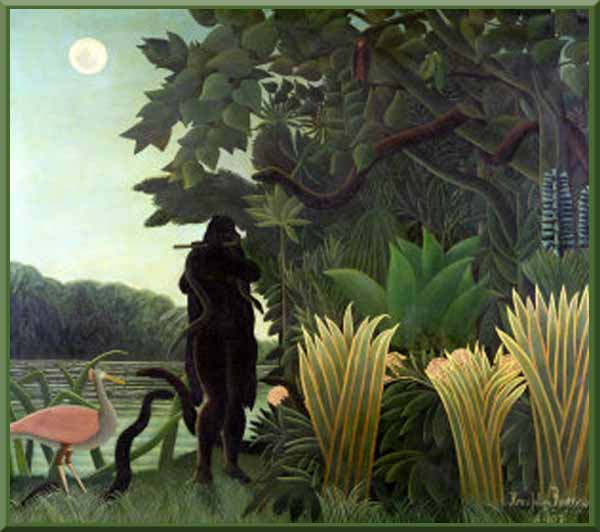The Archetypal Paintings of Henri Rousseau

1891

The Sleeping Gypsy
1897
Oil on canvas
51″ x 6’7″
The Museum of Modern Art, New York

1907
Oil on canvas
169 x 189.5 cm
Musee d’Orsay, Paris
From the National Gallery of Art:
Tiger in a Tropical Storm (Surprised!) was Rousseau’s first jungle painting. Although Rousseau never witnessed anything like the scene rendered, the subject matter was not unusual for its time, especially among academic painters, who regularly depicted exotic subjects. Exhibited at the Salon des Indépendants in 1891, the painting was ridiculed for its amateurish technique and childlike naïveté. But it also gained Rousseau his first serious review, from the young painter Félix Vallotton: “His tiger surprising its prey is a ‘must-see’; it’s the alpha and omega of painting and so disconcerting that, before so much competency and childish naïveté, the most deeply rooted convictions are held up and questioned.” Yet it was more than a decade before Rousseau returned to the jungle theme.
From Associated Content
Henri Rousseau’s The Snake Charmer hangs in the Orsay Museum in Paris, and reflects the 19th century romanticizing of wilderness and nature, which the civilized world began to realize was disappearing under the pressure of “development.” It was commissioned by Berthe, Comtesse de Delaunay, the mother of an artist friend of Rousseau’s, who commissioned it in 1907 and told Rousseau of her experiences in India. In European art centers, particularly Paris, the “exotic” was appealing, whether the tribal art of African masks, the silk and paintings form the newly opened markets in Japan, or the building of the elaborate greenhouses and zoo of the Jardin du Plantes Most of Rousseau’s last works were jungle scenes, although most critics prefer his first jungle from 1891: Tiger in Tropical Rainstorm. The Snake Charmer brought Rousseau acclaim, restoring his place in the art world to some extent, and it may have been an influence on the Fauves artists and in the development of surrealism due to the naïve representations and dreamlike stylization of his images . During his lifetime, however, “Le Dounier” Rousseau was often ridiculed by the art establishment as a Sunday painter for his lack of classical training and his dreamlike images that did not reflect either classical photographic likeness nor impressionistic verve.
From the Museum of Modern Art:
Rousseau described the subject of The Sleeping Gypsy as: “A wandering Negress, a mandolin player, lies with her jar beside her (a vase with drinking water), overcome by fatigue in a deep sleep. A lion chances to pass by, picks up her scent yet does not devour her. There is a moonlight effect, very poetic.” A toll collector for the city of Paris, Rousseau was largely a self-taught painter, although he had ambitions of entering the academy. This was never realized, but his sharp colors, fantastic imagery and precise outlines—derived from the style and subject matter popular print culture—struck a chord with a younger generation of avant-garde painters, including Pablo Picasso, Vasily Kandinsky, and Frida Kahlo.

